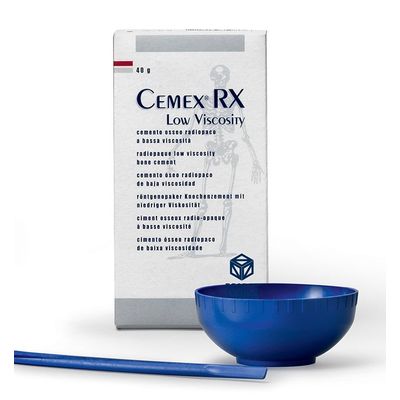

- Home
- Companies
- Tecres S.p.A.
- Products
- Cemex - Model RX - Orthopaedic Bone ...

Cemex - Model RX - Orthopaedic Bone Cement Without Antibiotics
Cemex® RX is the medium viscosity bone cement without antibiotic. Its medium viscosity makes it suitable for both syringe and manual applications (waiting time is a few minutes longer in manual applications). Available in the 40g pack. Cemex® is the bone cement designed by Tecres for joint implants fixation. Right from the start, the company focused on research and development of acrylic resins, creating a unique and revolutionary product in 1986. Since then, the outstanding features of Cemex® have remained unchanged and they are now available in every product of the complete range, making it the ideal cement for all needs. As shown by several international publications, Cemex® is a safe and reliable cement, with excellent mechanical performance12 and long-term clinical follow-up.
Bone cement is made up of polymers (powder) and a monomer (liquid); when the liquid component wets the surface of the powder it sets off a chemical reaction (known as polymerization). An exclusive process patented by Tecres gives to the powder particles of Cemex® a very smooth and uniform surface, making the cement very compact with extremely low porosity. The special powder of Cemex® needs less monomer than conventional bone cements found on the market.
This revolutionary feature puts Cemex® in a different league from the traditional powder-liquid ratio, providing the surgeon, the operating theatre staff and the patients with a number of significant and proven advantages:
A - Greater safety: with less monomer than any other cement on the market, Cemex® is the acrylic resin with the lowest toxicity for anyone coming into contact with it.
B - Less heat given off: every gram of monomer generates heat amounting to 130 Kcal. Cemex® requires less liquid, so the maximum temperature reached at the end of the chemical reaction is substantially lower, thus preserving surrounding tissues
C - Reduced shrinkage: shrinkage is the reduction in volume of the cement following its polymerization. It is directly proportional to the amount of liquid present. As the amount of monomer required is reduced, shrinkage is also reduced, thus greatly improving implant fixation.
